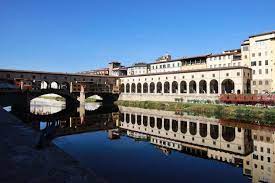Italy: Tourists arrested for spraying soccer graffiti on 460-year-old landmark

Rome: Not again! Yet another Italian historic landmark has been defaced by tourists in a summer that has seen the country endure a string of brazen incidents resulting in damage to celebrated works of architecture.
This time it was the turn of the 460-year-old Vasari Corridor, a beautiful riverside passageway connected to the famous Uffizi Galleries in Florence, which was sprayed with Munich soccer-related graffiti in the early hours of August 23.
The perpetrators of the alleged act of vandalism, according to the Florence arm of Italy’s Carabinieri military police, were two German tourists among a party of 11 students staying in an Airbnb in the center of the city.
“The Carabinieri of the Operations Unit of the Florence and of the Uffizi Carabinieri Station, analyzing video surveillance footage, managed to identify two individuals who, at 5.20 this morning, damaged the very important artistic site,” the Florentine Carabinieri said in a statement to CNN.
Italy’s Culture Ministry said the vandalism would require 10,000 euros worth ($10,800) of repairs, with work to be carried out under the watch of 24-hour armed guards.
The two suspects, aged 20 and 21, were monitored after they used spray paint to write on the ancient structure, the Carabinieri said. On Thursday their Airbnb was raided under a search warrant, and two cans of black spray paint and paint-stained clothing recovered.
Authorities said they are now comparing fingerprints from the paint cans to the 11 students who were all questioned in the matter.
The one-kilometer-long Vasari Corridor was built by Italian Renaissance painter and architect Giorgio Vasari in less than nine months in 1565.
It was intended as a secret covered route for the then leader of the Medici dynasty, Cosimo I de’Medici, between private family homes in the Boboli Gardens to what is now the Uffizi museums but was then the seat of governmental power.
The elevated passageway runs along the Arno river and across rooftops of central Florence and across the ancient Ponte Vecchio bridge.
It also passes through the basilica of Santa Felicita before reaching the Boboli gardens where the Medici dynasty lived. Dan Brown relied heavily on the secretive passageway in his book “Inferno” and created a fictional grotto where his protagonists hid.
The corridor was restored in 1973 but closed to the public in 2016 due to safety concerns over evacuation exits. The corridor has been undergoing work since 2019 to reopen it to the public.
The act of vandalism is the latest account of tourists behaving badly in Italy over the last year, which have run the gamut from defacements of the ancient colosseum in Rome to swimming in UNESCO-protected lagoons in Venice. Tourists have also hurled e-scooters and driven a Masareti down the Spanish Steps in Rome.
Florence Mayor Dario Nardella called the damage a “shameful act of vandalism” and stressed that those who damage Italy’s cultural heritage “commit a very serious crime.” The mayor’s office told CNN that the graffiti referred to a third-division German soccer club called TSV 1860 Munich. It’s not clear if any of the young German men were affiliated with the team.
Uffizi director Eike Schmidt condemned the “despicable act” and called for an “iron fist of the law” rather than symbolic punishment, which is often handed down to misbehaving tourists, primarily to skirt issues of extraditing them back to Italy.
Often misbehaving tourists are given nominal fines and prohibited from returning to the cities where they committed their crimes. Schmidt instead has called for prison terms for violators of any cultural heritage site.
Italy’s Culture Minister Gennaro Sangiuliano thanked officials for work in tracking down the culprits. “I would like to express my thanks to the Carabinieri for promptly identifying the alleged perpetrators of the Vasari Corridor in Florence. Acts like this must not go unpunished. Now justice takes its course,” he said in a statement.





